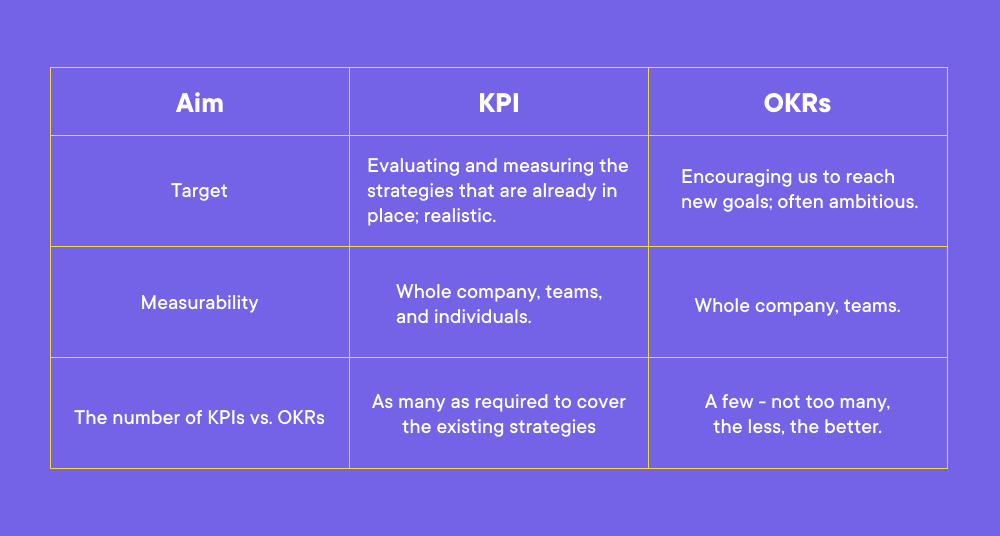KPIs vs. OKRs - choose your approach for measuring success in your business
Setting up and achieving goals is the foundation of every business. Clear-cut aims are essential to improve and expand a company. KPIs and OKRs are a part of the objective-setting process – they are the methods used to measure success. Yet, one must understand them in order to use them effectively – setting the wrong KPIs and OKRs might be detrimental. However, mistakes still happen due to the ambiguity between these two approaches. Therefore, in this article we aim to dispel any doubts by explaining the key differences between KPIs and OKRs – you will learn when and how to use each of them successfully.

Table of contents
What is a KPI?
KPI stands for key performance indicator. It is a method of performance evaluation. The role of KPIs is to measure the success of a business based on quantifiable features. Using assessable key performance indicators is a must – as Lord Kelvin said, “When you can measure what you are speaking about and measure it in numbers, you know something about it, when you cannot express it in numbers, your knowledge is of meager and unsatisfactory kind; it may be the beginning of knowledge but you have scarcely, in your thoughts advanced to the stage of science.”
KPIs are crucial because they allow you to see whether your current strategy is working. You set a reasonable, measurable aim for a certain period of time (for example Q1) and reevaluate it regularly. As a result, if the company goal is threatened, you can quickly gather the team to find out why you are not on track. This leads to a constant improvement of your strategy, thus boosting the efficiency of the whole organization.
KPIs do not have to necessarily be used only for whole-company aims. You might use this method to set objectives for particular departments, or even while setting sprint goals for your team. You might try to introduce them as a part of personal performance evaluation of your employees – as long as there are measurable aspects of their work that you will be able to analyze.
How do we use KPIs?
KPIs are an element of our goal-setting process at Boldare. We use them for several purposes, such as:
- Product quality: Tracking customer satisfaction ratings, defect rates, or other quality metrics to ensure that the developed products meet the desired standards of quality and reliability.
- Development cost: Monitoring the cost of product development, including research and development expenses, materials, and labor. This KPI helps ensure that the development process is cost-effective and efficient.
- Revenue growth: Tracking growth in product revenue over time. This KPI reflects the success of the product in generating sales and capturing market demand.
What are OKRs?
OKR stands for objective key results. It is a method used in several leading tech companies, such as Intel or Google. (okry.pl) As the name suggests, an OKR is divided into two parts: objectives and key results.
Objectives: What differentiates OKRs from KPIs is that the objective in the former is not measurable. For example, it could be: Breaking into the German market with our software development service. The quantifiable features come in the second part of OKRs – the key results.
Key results: These are the measurable goals which the company wants to achieve in order to fulfill its objective. There can be several key results used at the same time; preferably 3-5. For instance, returning to our previous example, the key results could be: receiving 30 requests per month, getting the first 10 clients, and increasing the organic traffic from Germany to our website by 75%.
OKRs are motivational targets that aim higher than what may seem possible. They do not include penalties or rewards. It’s recommended to have fewer OKRs for better focus. Company-level OKRs serve as the foundation for team-level OKRs, ensuring alignment. Objectives are qualitative and can utilize terms like “own” or “transform” to emphasize ownership and empowerment. They capture desired outcomes and inspire individuals and teams to excel.
How do we use OKRs?
We also use OKRs at Boldare. Here are some examples of how we do it:
Objective: Foster a collaborative and engaged team culture to drive client satisfaction and success.
Key Result: Employee satisfaction and retention
- Key Result: Maintain an employee satisfaction rating of at least 8 out of 10 based on regular surveys and feedback.
- Key Result: Achieve a retention rate of 85% for newly-hired team members over a one-year period.
Key Result: Client satisfaction and success
- Key Result: Meet or exceed client expectations by delivering the new product within the agreed timeline, quality standards, and client requirements.
- Key Result: Receive positive feedback from the client, reflected in a client satisfaction rating of 9 out of 10.
KPIs vs. OKRs comparison – the similarities and the differences
Since KPIs and OKRs are used for similar purposes, it is often difficult to choose one of them. Many people find the boundaries between these two approaches ambiguous. Therefore, we present a KPI vs. OKR comparison – a short summary that will make the distinctions between these two methods clear:

When to use: KPIs vs. OKRs?
Some companies opt for only one of these two methods. However, each of them is suited better for different purposes. This is why at Boldare we use both of them – we believe that combining KPIs and OKRs is the ideal solution. So, when are KPIs better and when should you use OKRs?
KPIs: This is efficient when evaluating the performance of already existing strategies. By setting a proper KPI, your company might see how effective its approach is, and react if there are any threats. It is good to use for measuring the efficiency of your employees – analyzing whether they meet their personal goals is crucial for their development. If something goes wrong, you will be able to dive into the issue and find solutions.
OKRs: Since OKRs are ambitious and a bit more complex, they are ideal for setting goals for new product development and its introduction to the market. However, while OKRs are efficient for building company- or team-level strategies, they might not work if established for individuals. Additionally, since they aim higher, meeting them might be time-consuming and exhausting – so, you should implement them only in the higher priority, large-scale projects.
Concluding thoughts
Both OKRs and KPIs are important success measuring methods for your company. The former are better for new, developing projects. The latter are exceptional for analyzing already existing strategies. Combining the two of them might be the golden mean – you can choose the better option for each situation, creating the most effective goal-setting system.
Share this article:








